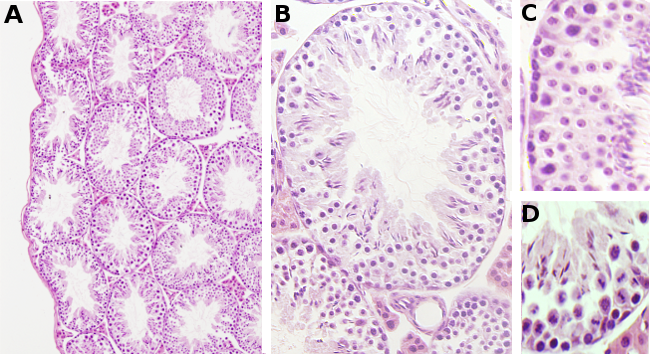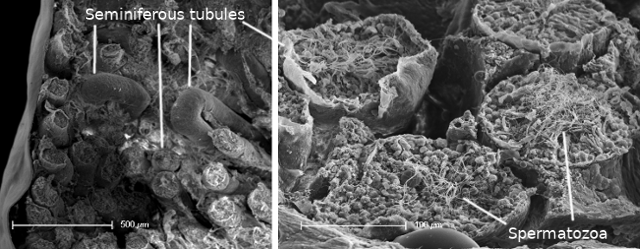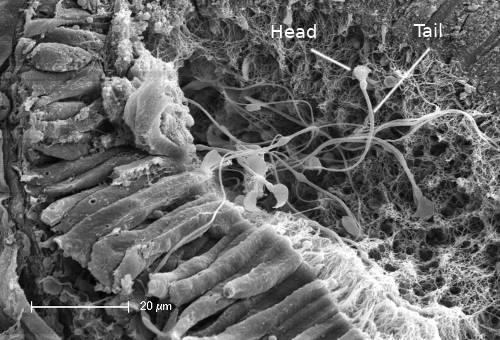Animal organs. Reproductive.
SEMINIFEROUS TUBULES

Species: mouse (Mus musculus).
Technique: paraffin embedding, staining with hematoxylin-eosin.
Seminiferous tubules are the sites in the testis where spermatogenesis, or gamete production, takes place. In humans, each seminiferous tubule may be 30 to 80 cm in length and around 150 to 250 µm in diameter. The germinative epithelium, or seminiferous epithelium, forms the wall of the tubule. It is a stratified epithelium composed of germinal cells in different stages of spermatogenesis, i.e., from spermatogonia to spermatozoa. Furthermore, among the reproductive cells, there are scattered somatic cells known as Sertoli cells. The limiting layer or tunica propria is a layer of connective tissue lining the external surface of seminiferous tubule.

Germ cells receive different names according to the stage of spermatogenesis. Type A spermatogonia are the stem cells that can produce more type A spermatogonia by mitosis, but from time to time they give rise to other cells that start the spermatogenesis to give gametes. Type A spermatogonia are found in the basal part of the germinative epithelium, attached to the basal lamina of the limiting layer. When a type A spermatogonia looses contact with the limiting layer, it starts an initial process of mitosis that results in a cohort of many type B spermatogonia. These cells are committed to go through spermatogenesis. After several rounds of mitosis, type B spermatogonia are differentiated into primary spermatocytes, which undergo DNA recombination in prophase I and division in metaphase I. Secondary spermatocytes result after telophase I. These cells go through meiosis II to give spermatids. As a result of the two meiotic divisions, four spermatids are obtained from one primary spermatocyte. Spermatids are haploid cells.
Spermatids undergo a dramatic transformation known as spermiogenesis to become a sperm cell. During this process, a flagellum is formed, vesicles from the Golgi complex with many hydrolytic enzymes fuse to form the acrosome, most of the cytoplasm is lost and the DNA is highly condensed.

All the differentiation stages of meiosis can be observed in the germinal epithelium, although they are difficult to distinguish after a general staining. The meiosis progresses from the periphery to the lumen of the seminiferous tubules, so that spermatogonia are located near the external layer and the spermatids toward the lumen. All the remaining stages are found between the basal and the apical (lumen) surfaces of the germinal epithelium.
Sertoli cells are located intermingled between spermatogonia. They are large cells, showing ovoid or triangular shapes, with clear and sometimes indented nucleus, and a patent nucleolus. The nucleus is found near the basal lamina of the germinal epithelium, and the cytoplasm sends extensions toward the apical surface of the epithelium and laterally as well. These cytoplasmic protrusions occupy spaces between the germinal cells. Sertoli cells provide support to germinal cells. The cytoplasmic extensions of near Sertoli cells are connected by cell adhesion complexes to make a network along the seminiferous tubule. Besides the structural role, Sertoli cells release testicular fluid that fills the lumen of seminiferous tubes and hormones like inhibin that influences the activity of the hypophysis. In mammals, Sertoli cells do not divide after puberty.
Leydig cells are found among the seminiferous tubules. They are rounded and large cells with affinity for the eosin-like staining and show intracellular deposits of lipids. Leyidig cells released testosterone from the early stages of the fetus development until adult stages. The function of testosterone during fetal development is transform the gonadal ridges into testis, and during puberty it stimulates the production of sperm and the development of the secondary sexual characteristics. In adult stages, testosterone is needed to maintain the male characteristics.
Tunica propia is a layer of connective tissue lining the external surface of the seminiferous tubules. It does not contain typical fibroblasts, but other cells with contractile abilities known as myoid cells. The periodic contractions of these cells help to move the testicular liquid, and therefore the sperm, along the seminiferous tubules.
